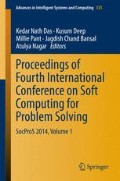Abstract
Face recognition has always been an area of interest for the researchers because it seems so fascinating in itself. As the time has passed, the evolution of human brain and social intelligence has enhanced the analysing power of a human brain for the displaying of face to infer the emotion accordingly. Face of a human being is considered to be the most common channel to read and infer the emotion in the case of mind reading. Theory of mind (ToM) is the inbuilt technique provided to every human being “as reported by Premack and Woodruff (Behav Brain Sci 1:515–523, 1991)”. According to ToM, a person has the ability to read someone else’ mind. Mind reading has a great amount of future advancement if worked upon with the different equipment and devices in the high-tech laboratories. The researchers have worked in this direction and have developed softwares. The aim of such software is to apply concept of security in face recognition but still there is a scope for improvement. This paper presents a comparative study between algorithms used for detecting the face as the key component in mind reading. Further, a model is proposed to enhance the security in face recognition. The proposed model also suggests interface that would help users to identify the people watching their pictures posted online.
Access this chapter
Tax calculation will be finalised at checkout
Purchases are for personal use only
References
Premack, D., Woodruff, G.: Does the chimpanzee have a theory of mind? Behav. Brain Sci. 1, 515–523 (1991)
Bhargava D., Saxena S.: RoHeMaSys: Medical Revolution with Design and Development of Humanoid for Supporting Healthcare. Advances in Intelligent Systems and Computing, Proceedings of the Third International Conference on Soft Computing for Problem Solving. Springer India, vol. 258 pp. 133-142 (2014)
Bhargava, D., Sinha, M.: Performance analysis of agent based IPSM. International Joint Conference on Computer Science and Software Engineering (JCSSE), pp. 253–258, IEEE (2012)
Masanori, T., Arita, T.: Asymmetry between even and odd levels of recursion in a theory of mind. In: Proceedings of ALIFE X, pp. 405–411 (2006)
Corballis, M.C.: Recursion as the key to the human mind. In: Sterelny, K., Fitness, J. (eds.) From Mating to Mentality: Evaluating Evolutionary Psychology, pp. 155–171. Psychology Press, New York (2003)
Dunbar, R. On the origin of the human mind. In: Carruthers, P., Chamberlain, A. (eds.) The Evolution of Mind, pp. 238–253. Cambridge University Press, Cambridge (2000)
El Kaliouby, R., Robinson, P.: Mind reading machines: automated inference of cognitive mental states from video. IEEE International Conference on Systems, Man and Cybernetics, vol. 1, IEEE (2004)
Petersen, M.K. et al.: Smartphones get emotional: mind reading images and reconstructing the neural sources. In: Affective Computing and Intelligent Interaction, pp. 578–587. Springer, Berlin (2011)
Golan, O., Baron-Cohen, S.: Systemizing empathy: teaching adults with Asperger syndrome or high-functioning autism to recognize complex emotions using interactive multimedia. Dev. Psychopathol. 18(02), 591–617 (2006)
Fattouh, A., Odile, H., Guy, B.: Emotional BCI control of a smart wheelchair. Int. J. Comput. Sci. Issues (IJCSI) 10, 3 (2013)
Barkow, J.H., Cosmides,L.E., Tooby, J.E.: The Adapted Mind: Evolutionary Psychology and the Generation of Culture. Oxford University Press, Oxford (1992)
Bhargava D., Sinha M.: Design and implementation of agent based inter process synchronization manager. Int.J. Comput. Appl. (IJCA) 46, 21 (2012). doi: 10.5120/7065-9670
Author information
Authors and Affiliations
Corresponding author
Editor information
Editors and Affiliations
Rights and permissions
Copyright information
© 2015 Springer India
About this paper
Cite this paper
Vyas, V., Saxena, S., Bhargava, D. (2015). Mind Reading by Face Recognition Using Security Enhancement Model. In: Das, K., Deep, K., Pant, M., Bansal, J., Nagar, A. (eds) Proceedings of Fourth International Conference on Soft Computing for Problem Solving. Advances in Intelligent Systems and Computing, vol 335. Springer, New Delhi. https://doi.org/10.1007/978-81-322-2217-0_15
Download citation
DOI: https://doi.org/10.1007/978-81-322-2217-0_15
Published:
Publisher Name: Springer, New Delhi
Print ISBN: 978-81-322-2216-3
Online ISBN: 978-81-322-2217-0
eBook Packages: EngineeringEngineering (R0)

